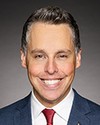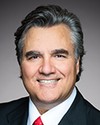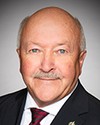Thank you.
I wish I could join you in person today, but I'm glad to be here to make an appearance.
I'm in Gander in central Newfoundland, which may not be technically considered remote, but on my morning commute this morning, I passed two moose and just three stoplights, so it is, in fact, rural. Like most rural communities, central Newfoundland is a very trade-dependent economy. It's home to a billion-dollar perishables industry, notably fisheries and aquaculture. A nascent coal industry is creating thousands of jobs. Tourism is a crucial economic generator, and there's a big flow here of people, labour and services.
In this big, beautiful home we all call Canada, aviation is really the load-bearing wall that holds us all together. It's no mistake, there are some pretty wide foundational cracks that have developed since the pandemic, and it has some of us listing for sure.
Despite COVID-19 receding in the rear-view mirror, our airport here in Gander has only recovered two-thirds of its 2019 passengers. There are other airports in Canada facing much worse, some on the precipice of closure.
You'll know airports are crucial public assets, but they also operate as a business. The primary business of an airport clearly is airplanes and passengers, neither of which has really recovered in many cases. Even in the earliest days of the pandemic, it was very clear that air travel would become less convenient and more expensive.
There's also a fairly clear divide between how passenger traffic and air service have returned to large, urban hubs versus regional markets like ours. I knew then, and I see it now, that clearly the smaller airports would be the last dogs to the bowl of recovery.
This is where we sit today. There are four real, major influences there, forming a sort of—I can't say a Bermuda triangle—Bermuda rectangle for Canadian travel, which we're coping with now, collectively.
The first is that there's an acute pilot shortage, which is improving, but still a challenge. This naturally favours larger aircraft flying between larger cities to achieve economies of scale. It's not just in the cockpit. There's a shortage of qualified personnel in control towers, in the maintenance hangar, behind the counter, below the wing, at the border and in other key areas.
The second is that airline mergers and retrenchment of service at hubs have disproportionately affected smaller Canadian markets. There are some fleet issues as well in terms of aircraft availability, but more particularly the retirement of airplanes in the sub-50-seat market.
I can tell you here in Atlantic Canada, in particular, travel within the Maritimes has only recovered about 60%. It's really been eviscerated.
On the cost of everything, as we all know as consumers and community leaders, the cost of everything is up: labour, fuel-borrowing materials and all of those things. All of those inputs are up over 2019, clearly.
It's important to remember that every airline in our nation exists to do an important job for all of us, but also they need to produce returns for shareholders or owners, and that's often done with a quarterly lens. There's nothing wrong with this. Canada's airlines do a great job largely, and they must be well capitalized and financially healthy. However, that mandate contradicts the social and economic utility of dependable air service for rural communities.
Ultimately, it puts airlines in a position where they're choosing winners and losers, and they have an outsized voice in which communities flourish and which perish. None of us wants a Canada where only a dozen urban hubs have timely, affordable air service. Rural economies need air access if they're going to remain fertile ground for economic growth.
A couple of weeks ago, I was at a meeting of all of the Canadian airport CEOs, and we did discuss at that point the need for a true, renewed national aviation strategy. The national airports policy, which guides airport operation, and the blue sky policy, which informs international, bilateral air service agreements, are almost 30 years old now, yet we continue to use them as guideposts. Aviation has changed profoundly over those three decades, and the policy compass really needs to be recalibrated.
In my view, part of that strategy should include a couple of things. One is reviewing foreign ownership and fifth freedom rights within Canada. The second will be working with the airline and industry sectors to recruit new talent, with an emphasis on pilots, but there are certainly other key positions in deficit.
Government should probably have an assessment of the role it can play in subsidizing and guaranteeing a base level of air service for rural and remote communities, as happens in the EU, United States, Australia and here in Canada to some extent too.
In addition, there's working with the aircraft manufacturers to incentivize the production of sub-70-seat aircraft that can operate profitably—and I stress profitably—in small, light-density spoke markets. In the interim, I think more money probably needs to be made available for all small airports for safety-related capital. This is a universal call.
All of these things take money. There's that recognition, and we do also recognize this is a time of austerity and a time of constraint. I will say this though, combined, airports pay the federal government $400 million in rent, annually. These funds are not earmarked for reinvestment in the national air network. Instead, they go to treasury.
It can be frustrating, because there certainly seems to be widespread recognition among elected officials of all stripes. Policy-makers at Transport Canada and Infrastructure Canada and in tourism do seem to understand that reinvesting a portion of that $400 million to strengthen safety and service and make air travel affordable for middle-class Canadians would be a very good investment.
In terms of the current context, there are still some very material impacts on our airport. Right now, our balance sheet is a little broken and our recovery keeps getting pushed further out on the horizon. There are going to be severe tests for Gander and other small airports going forward.
I'll close by saying it's really important that we act collectively and deliberately and keep Canada's best interests at the forefront of our minds.
Thank you.










